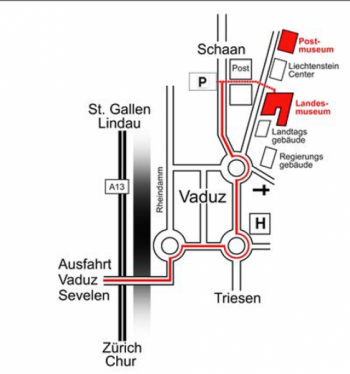Contents
Description

Copyright: Liechtenstein Marketing
The Exhibition
The Liechtenstein National Museum encompasses a total of 42 exhibition rooms, showing samples depicting Liechtenstein's history. The spectrum of samples in the museum is quite large, spanning from archaeological excavations originating in the Neolithic Age up to present-day findings, among which one finds articles of daily use such as weapons or agricultural appliances and relics of art.
Since the museum's re-opening in 2003, a natural history collection about the flora and fauna of this particular Alpine region has been made accessible to the public.
Special Exhibitions
Every now and then, there are special exhibitions presenting particular topics such as eastern European icon art or an exhibition highlighting the work of the Liechtenstein composer Josef Gabriel Rheinberger.
Outposted Sections of the Museum
The museum has two outposted sections. On the one hand, there is the “Postmuseum” which shows historical postage stamps and the history of the Post Office in Liechtenstein. It is accommodated in the so-called “Engländerbau”, literally the building of the English, in Vaduz, Liechtenstein's capital city. The “Bäuerliches Wohnmuseum” in Schellenberg, on the other hand, is dedicated to early types of construction and the everyday life of Liechtenstein's past generations.
Historical Information

Copyright: Liechtenstein Marketing
The History of the Building
According to dendrochronological investigations and research, the Liechtenstein National Museum is accommodated in a building that can be dated back to the year 1438. It used to be a lordly tavern, then a customs station and also even the seat of Government.
From 1999 to 2003 the building was reconstructed. Towards the slope an extension of the building can be now found.
The Foundation of the Museum
The museum was founded by Prince Johann II of Liechtenstein towards the end of the 19th century, pursuing the objective of the collection and protection of Liechtenstein's cultural assets. The first collection was accommodated in Vaduz Castle.
Relocation and Re-opening
The entire collection was relocated to the upper floor of the Liechtenstein Landesbank, the regional state bank of Liechtenstein, in 1954. Twelve years later, in 1966, the collection had to be moved and spread over various other buildings up and until 1972. That year the museum was relocated to a former tavern, the “Herrschaftliche Taverne zum Adler”. Due to severe damages to the building, though, the museum had to be relocated yet again in 1992. Since 1999 the National Museum had undergone a renovation process until it was re-opened and made publicly accessible again in 2003.
Interesting facts
- Liechtenstein National Museum is the the best rated tourist attraction in Liechtenstein.
- The day pass at Liechtenstein National Museum is CHF10 making it one of the 3 cheapest tourist Attractions in Liechtenstein.
How to get there
The Liechtenstein National Museum is located next to the statehouse in the centre of Vaduz, Liechtenstein's capital city.
By public transport
You will get to the museum by using a bus starting at the train stations in Sargans and Buchs, both Switzerland or in Feldkirch, Austria. Get off at the bus stop “Vaduz, Post”. From here to the museum it's only a 100m (110yd) walking distance further east.
By car
From the direction of Switzerland
Starting your journey in Switzerland, you first take the A13/ E43. Take the exit at Vaduz and leave the “Rheindamm-Kreisel” roundabout via its first exit. Then, in the “Au-Kreisel” roundabout, you take the third exit and, afterwards, either the second or third exit to leave the “Linden-Kreisel” roundabout. And here you are in the centre of Vaduz. Find a car park and comfortably walk to the museum.
From the direction of Austria
Starting your journey in Austria, you first need to get on the A14/ E60. Take the exit at Feldkirch/ Frastanz and carry on further south towards Vaduz. You cross the border checkpoint Tisis, passing Schaanwald, Nendeln and Schaan until you arrive in Vaduz. In the “Adler-Kreisel” roundabout you opt for the second exit and here you are in the centre of Vaduz. Now you can start looking for a car park and comfortably walk to the museum.


















